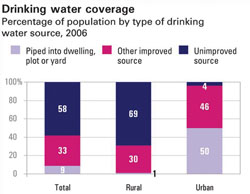
We begin this study session by describing the public health significance of water. A satisfactory water supply must be available to all humans. By ‘satisfactory' we mean water must be available in adequate quantity, be safe to drink and be accessible. Improving access to safe drinking water can result in tangible benefits to health so every effort should be made to achieve drinking water quality that is as safe as is practicably possible.
The great majority of water-related health problems are the result of microbial (bacteriological, viral, protozoan or other biological) contamination. Infectious waterborne diseases such as diarrhoea, typhoid and cholera are leading causes of death and illness in the developing world. There are many diseases associated with water, which can be classified as waterborne, water-washed, water-based and water-related (Box 13.1).
Several terms are used to describe the types of disease associated with water. These are:
Waterborne diseases are those caused by ingestion of water that is contaminated by human or animal excrement and contains pathogenic microorganisms. Transmission occurs by drinking contaminated water. Waterborne diseases include most of the enteric and diarrhoeal diseases caused by bacteria and viruses, including cholera, typhoid and bacillary dysentery. They also include diseases caused by protozoa (single-celled microorganisms) such as giardiasis, amoebic dysentery and cryptosporidiosis.
Water-washed diseases are caused by poor personal hygiene, and skin and eye contact with contaminated water. They are also sometimes known as water-scarce diseases because they occur when there is not enough water available for adequate personal washing. They include scabies, trachoma, typhus, and other flea, lice and tick-borne diseases.
Water-based diseases are caused by parasites that spend part of their lifecycle in water. For example, schistosomiasis and dracunculiasis are both water-based diseases caused by helminths (parasitic worms). Schistosomiasis (also known as bilharzia) is caused by a worm that spends part of its lifecycle in the body of a particular species of water snail. People can become infected from swimming or wading in infected water. Dracunculiasis or guinea worm is transmitted by drinking water that is contaminated with copepods (very small crustaceans) that contain the larvae of the worm.
Water-related diseases are caused by insect vectors, especially mosquitoes, that breed or feed near water. They are not typically associated with lack of access to clean drinking water or sanitation services. Water-related diseases include dengue fever, filariasis, malaria, onchocerciasis, trypanosomiasis and yellow fever.
Note that, rather confusingly, the term ‘water-related' is sometimes used to mean all the above, i.e. all diseases associated with water.
Chemical contamination of water is another potential cause of health problems. In some places, water may contain naturally occurring toxic chemicals such as arsenic and fluoride. Other chemicals may get into the water supply because of pollution. Lead poisoning, for example, can result from water contaminated with lead. These diseases are also classified as waterborne diseases.
Safe water is water which is free from disease-causing agents and does not have any significant risk to health over a lifetime of consumption. The term potable water is also sometimes used; ‘potable' means safe to drink. A related but different term is palatable water, which means water that is pleasant to drink. Palatable water is at a desirable temperature, completely transparent and free from tastes, odours and colours, but is not necessarily free from disease-causing agents. Safe drinking water is suitable for all usual domestic purposes, including personal hygiene. Access to safe and affordable water is considered to be a basic human right.
Many million individuals in Ethiopia have to get their water from unsafe sources and this makes them vulnerable to waterborne disease. Figure 13.1 shows the relative proportions of people in Ethiopia with access to improved and unimproved sources (see also Box 13.2).

Look at the bar graph in Figure 13.1. What proportion of the rural population in Ethiopia obtains their water from unimproved sources? And what proportion of the urban population?
69% of the rural population and 4% of the urban population get their water from unimproved sources.
Water source simply means water in its natural environment that is used by people to meet their need for water. Common water sources are groundwater, surface water such as rivers and lakes, spring water, and rainwater.
Water sources can be described as protected or unprotected. Unprotected sources are those where there is no barrier or other structure to protect the water from contamination. Protected sources, on the other hand, are covered by stonework, cement or other material that prevents the entry of any physical, chemical or biological contaminant. Water from a protected source is likely to be safe to drink but water from unprotected sources cannot be considered safe.
The terms improved and unimproved sources may also be used, as in Figure 13.1. These terms are broadly equivalent to protected and unprotected. Improved drinking water sources include household connections, public standpipes and water points, boreholes, protected dug wells, protected springs and rainwater collections. Unimproved water sources include rivers, lakes, unprotected wells and unprotected springs.
Using the data in Figure 13.1, in general terms, what fraction of the rural Ethiopian population uses an unimproved water source?
69% of rural people use an unimproved water source. This is roughly equivalent to two-thirds of the population (two-thirds equals 66.7%).
The provision of safe water and sanitation is not only essential for disease prevention, it is also a key mechanism required to break the cycle of poverty, particularly for women and girls. Lack of access to water may limit the use of latrines because the need for handwashing creates an additional water requirement and therefore an additional burden on the person responsible for collecting water. With improved access to safe water, women and girls have more time to tend to crops and livestock, more time and resources to spend on improved food preparation, more time to attend school, and an opportunity to participate in the local economy. These are all mechanisms for breaking the cycle of poverty.